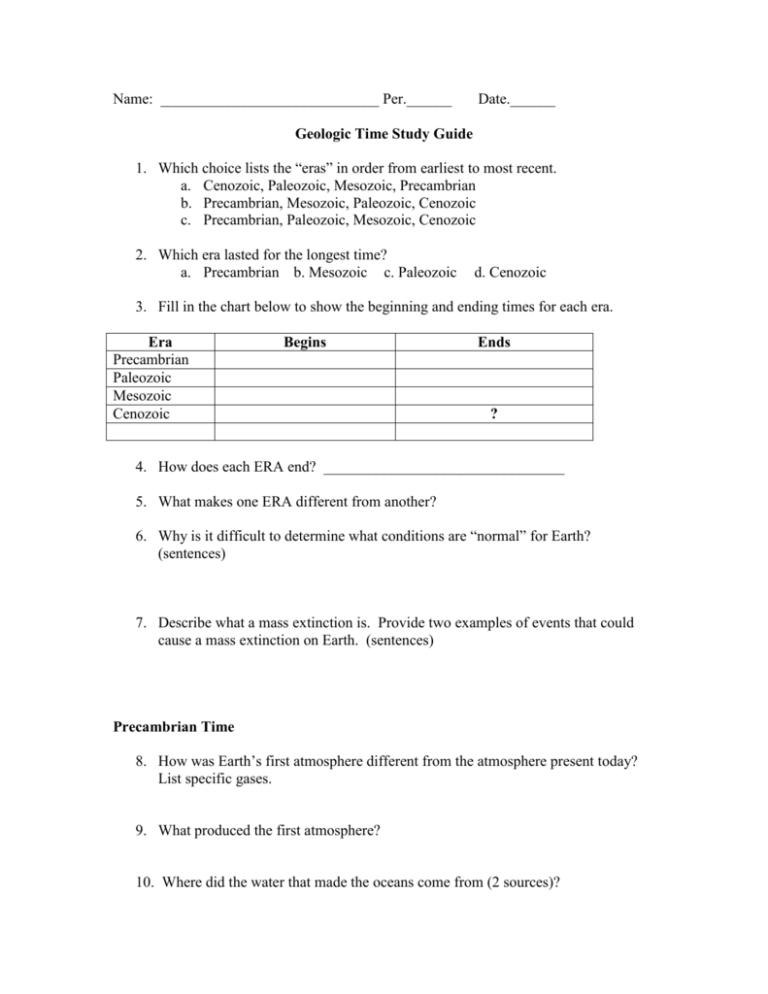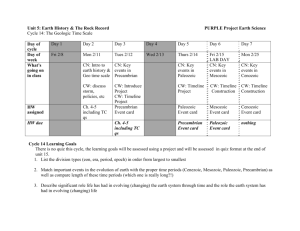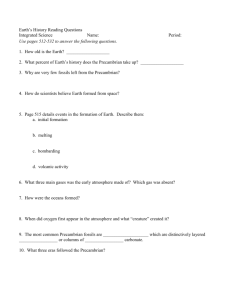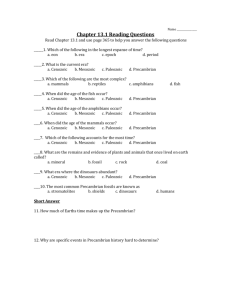Geologic Time Study Guide: Eras, Events, and Extinctions
advertisement

Name: _____________________________ Per.______ Date.______ Geologic Time Study Guide 1. Which choice lists the “eras” in order from earliest to most recent. a. Cenozoic, Paleozoic, Mesozoic, Precambrian b. Precambrian, Mesozoic, Paleozoic, Cenozoic c. Precambrian, Paleozoic, Mesozoic, Cenozoic 2. Which era lasted for the longest time? a. Precambrian b. Mesozoic c. Paleozoic d. Cenozoic 3. Fill in the chart below to show the beginning and ending times for each era. Era Precambrian Paleozoic Mesozoic Cenozoic Begins Ends ? 4. How does each ERA end? ________________________________ 5. What makes one ERA different from another? 6. Why is it difficult to determine what conditions are “normal” for Earth? (sentences) 7. Describe what a mass extinction is. Provide two examples of events that could cause a mass extinction on Earth. (sentences) Precambrian Time 8. How was Earth’s first atmosphere different from the atmosphere present today? List specific gases. 9. What produced the first atmosphere? 10. Where did the water that made the oceans come from (2 sources)? 11. When did the first living organism appear in the fossil record? What was this organisms like? 12. How did the arrival of photosynthetic bacteria (stromatolites) change Earth’s atmosphere? 13. How did the arrival of photosynthetic bacteria (stromatolites) change Earth’s climate? Explain. 14. By the end of the Precambrian, how advanced was life? 15. What was one condition preventing life from living on land during Precambrian time? 16. What caused the mass extinction that ended Precambrian time? Paleozoic 17. What is responsible for pulling Earth out of its SNOWBALL EARTH episode? (Be specific). 18. What was the “Cambrian Explosion”? Describe it. 19. What change in conditions allowed life forms to live on land during the Paleozoic? 20. What benefit does ozone provide for organisms on Earth? What molecule is ozone made from? 21. Describe how life during the Paleozoic differed from life during Precambrian time. 22. Most of our fossil fuels come from organic matter from this era. Describe how coal deposits are formed? What does it form from and how does this relate to the Paleozoic 23. The “Great Dying” is the biggest mass extinction in the fossil record. What is a possible cause of this extinction? Describe this event. Mesozoic 24. Describe basic climate and life forms associated with the Mesozoic. 25. Why was it so warm during the Mesozoic? 26. Pangaea broke up during this era. What causes this? 27. What are the TWO events contributed to the mass extinction of the dinosaurs. 28. What evidence supports the theory that an asteroid impact caused this extinction? Be specific (sentences). Cenozoic 29. How does the climate of the Cenozoic compare to that of the Mesozoic? 30. When and where did the human species evolve? 31. What may have triggered the series of ice ages that characterize the Cenozoic? Name that “Era” Write the name of the “era” associated with each description or development. 31. 32. 33. 34. 35. 36. 37. 38. 39. 40. 41. 44. 45. 46. 47. 48. 49. 50. _____________________Pangaea forms _____________________1st life _____________________Green oceans, red skies _____________________Dinosaur Age _____________________Life in shallow seas _____________________Age of Mammals _____________________Life invades land (amphibians, land plants, reptiles, giant insects). _____________________Earth forms by cooling from a molten blob. ___________________ 1st continents form. ___________________ 1st photosynthesizing organisms ___________________ Pangaea breaks apart ___________________ Warm temperatures; No ice caps; Tropical forests ___________________ Ends with SNOWBALL EARTH ___________________ Series of closely spaced ice ages and mountain building ___________________ Giant trees and swamps become today’s coal. ___________________ Ozone develops from oxygen. ___________________ Reefs. Reefs. Reefs. ___________________ Mammals appear for the first time.










